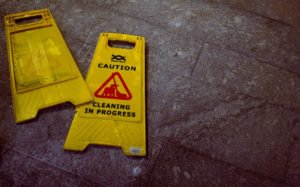workplace safety
Six tips to improve workplace safety
Whether your premises is an office, a warehouse, a shop, or anywhere, it is important to practice good safety in the workplace.
This is something that all businesses need to take seriously in order to ensure that staff, visitors, and the general public are completely safe at the property. Here we provide six tips to help your business improve workplace safety.
Provide training to your staff
 Undoubtedly one of the most important steps in ensuring safety in the workplace is in making sure that your staff know how to be safe. In virtually any kind of, whether it involves manual labour or in an office role behind a desk, there are things that people can be doing that may not be safe, and you need to make sure they are given appropriate training.
Undoubtedly one of the most important steps in ensuring safety in the workplace is in making sure that your staff know how to be safe. In virtually any kind of, whether it involves manual labour or in an office role behind a desk, there are things that people can be doing that may not be safe, and you need to make sure they are given appropriate training.
Set up a safety training programme to help your staff understand what is expected of them at work, and what they should be doing. It is not necessarily going to be enough to simply have one session when they start. Workplace safety training should be regularly updated and improved, and staff should be given these updates.
Have regular asbestos tests
Asbestos is another issue that is a real scourge in the workplace. The substance is directly responsible for in excess of 2,500 deaths in the UK alone every year and the majority of those who died were exposed to asbestos as a part of their work.
Things are not as bad as they once were, and the asbestos ban in 1999 has certainly improved things. However, asbestos can still be present in workplaces across the country and it is important to be aware of the dangers it poses. If you work in a building that could contain asbestos – any premises built before 2000 – your business needs to conduct asbestos surveys through specialist providers.
Ensure that correct breaks are being taken
Employees are entitled to take rest breaks when working long shifts, the nature of these breaks can differ, however, workers have a right to one uninterrupted 20-minute break if they work for more than 6 hours in a day. It is important not only that employers allow these breaks – but that they ensure staff take them.
Some staff will prefer the idea of working through their break. However, this can make them tired or lead to them being careless while working, not only potentially endangering themselves but also those around them. Make sure that the correct rules around breaks are being followed.
A clean workplace is a safe workplace
 It is also important to make sure that your workplace is clean and tidy. This is not just from the perspective of making it look better – tidier workplaces are much safer because there is less likely to be anything in the way of obstacles or even spillages that could make it possible for some to have an accident.
It is also important to make sure that your workplace is clean and tidy. This is not just from the perspective of making it look better – tidier workplaces are much safer because there is less likely to be anything in the way of obstacles or even spillages that could make it possible for some to have an accident.
Ensure that your workplace is regularly cleaned and that staff take a sensible approach to keeping things orderly and tidy. It’s not just the obvious stuff like mopping up spills and keeping corridors free from objects, it also comes down to ensure that items are only ever stored in their correct places.
Put up signs
Good signage is also a crucial part of workplace safety. Signs can firstly be important in terms of informing staff about potential dangers, such as explaining when they need to be wearing high-vis jackets and hard hats. However, they can also be very useful in encouraging good safety practice throughout the business.
Have signage up that reminds staff to be vigilant and follow all of the relevant safety procedures – it really does make a big difference.
Consult with employees on matters of safety
Finally, it is a great idea to regularly consult with employees on safety matters in the workplace. They will often be best placed to raise concerns and reveal issues in the premises that need to be dealt with, as they are the ones doing it every day.
This can also be important for staff morale, as it is important that your staff feel that they are listened to and their concerns are taken seriously.
Six tips to improve workplace safety
Whether your premises is an office, a warehouse, a shop, or anywhere, it is important to practice good safety in the workplace.
Dakota Murphey
SHP - Health and Safety News, Legislation, PPE, CPD and Resources Related Topics
Navigating turbulence: Boeing’s lessons in risk management
Man handed community order for illegal removal of asbestos
Mavis Nye 1941 – 2023



Expected to find a few more in addition to the standard minimum very very basic “Given Condition” that fall far short of supporting low level wellbeing with debilitating eye-strain, CVS or Screen Farigue let alone, anything like optimal and/or sustainable reasonably practicable needs driven set of “Given Condition” in which Wellbeing IS sustainable and somewhere near “optimal to thrive and go home well”, enough not to feel the need to work at home to catch-up everyday before getting a disrupted nights sleep and trying to repeat constantly fatigued suffering presenteeism …
FOR SHP very low level article – if targeted at novices maybe suitable but SHP readers are competent persons – looking for a more interesting article.
Also find odd that Asbestos features so signficantly – what about fire precautions, chemicals, work at heights, machinery
and ‘put up signs’ doesn’t actually affect the hazard and has limited effect on behaviours
moan over
Thanks Martin, appreciate your feedback. Our readers are from a range of experience levels and backgrounds, so we have to try and appeal to as many as possible with our content. Certainly understand if this was a little simplistic for more experienced practitioners.
Oh, really great tips! By the way, the construction industry is recognized as the most dangerous industry to work in. Although you’re right, there is no place that is absolutely safe. I think an office where safety rules are not followed is more dangerous than a construction site where this is monitored. Do you agree?